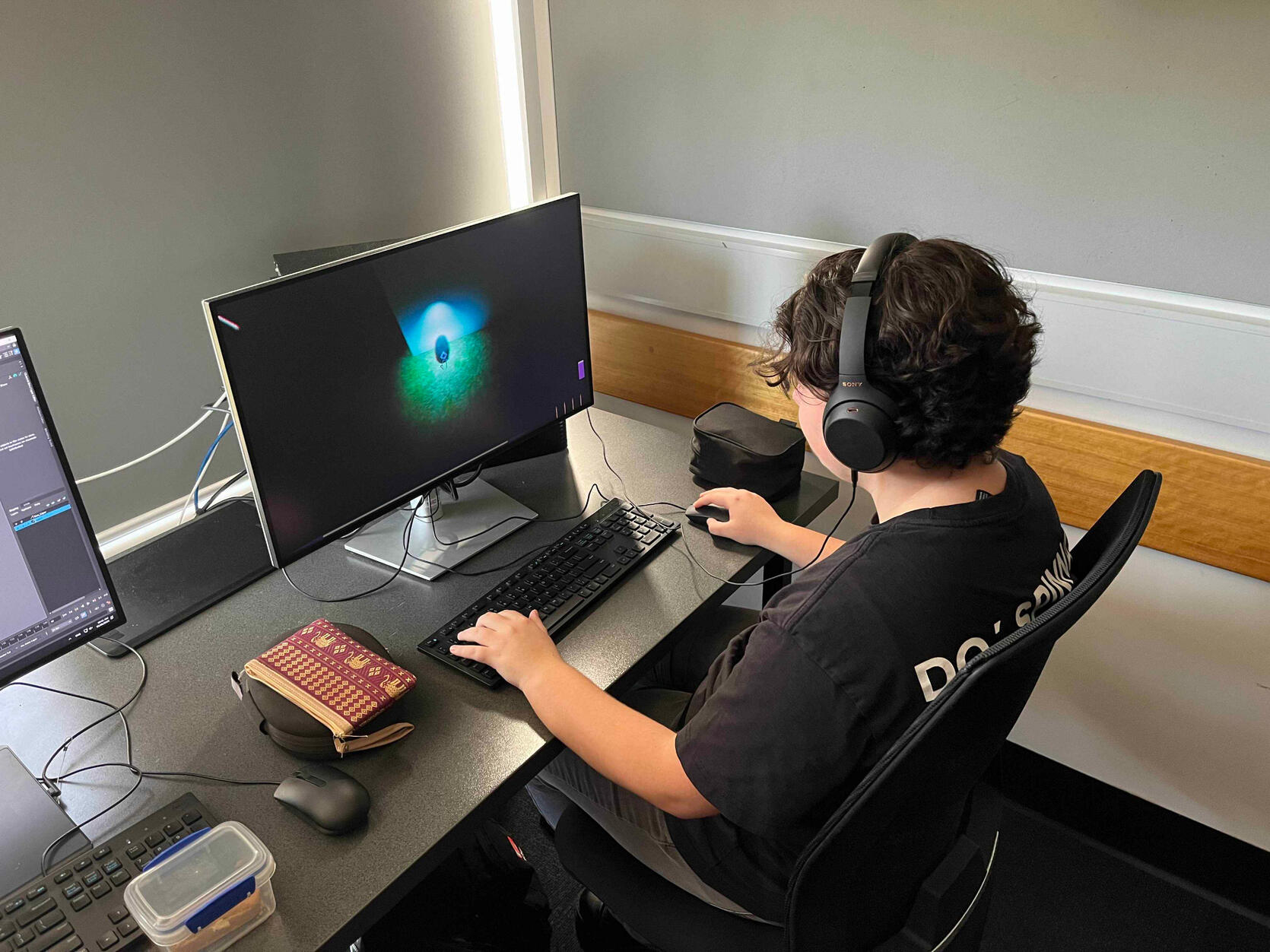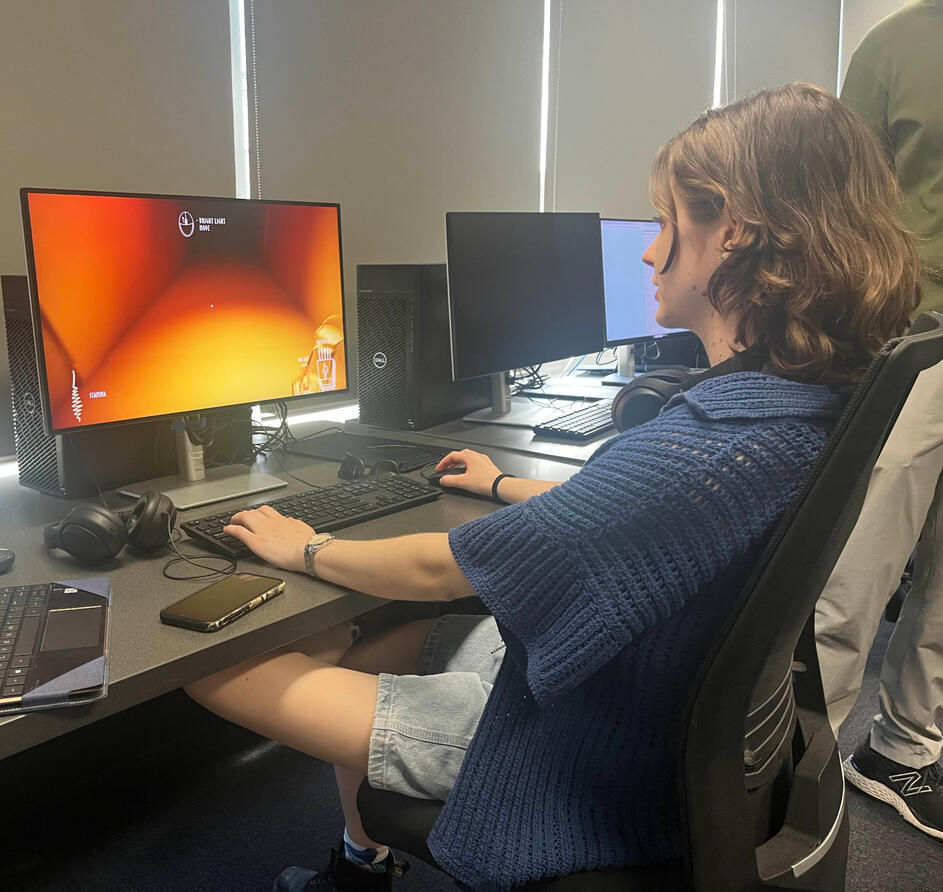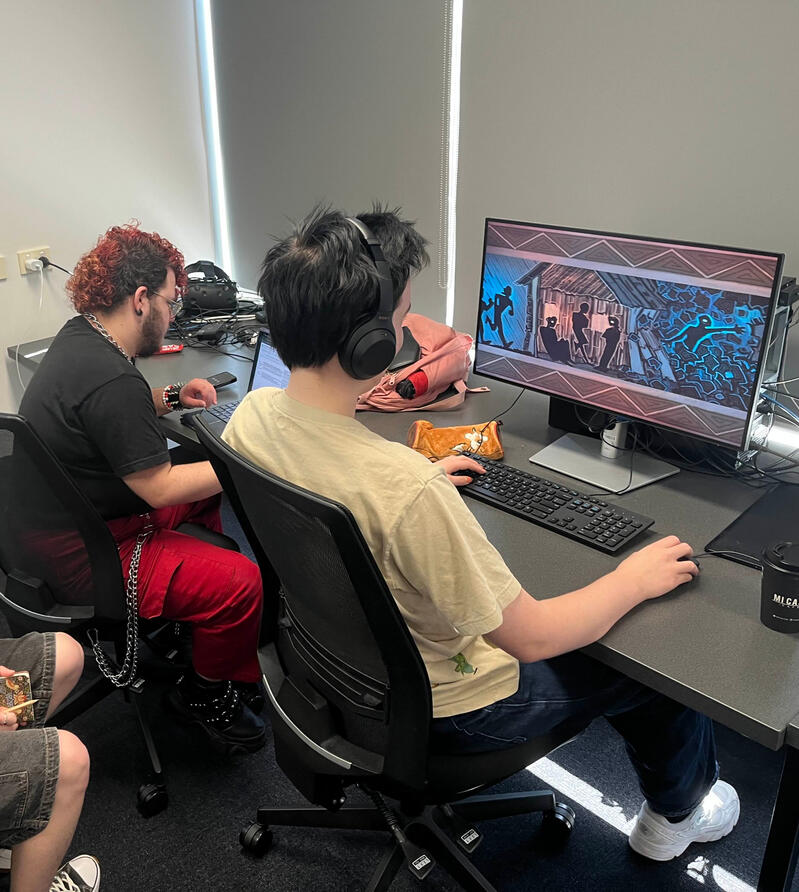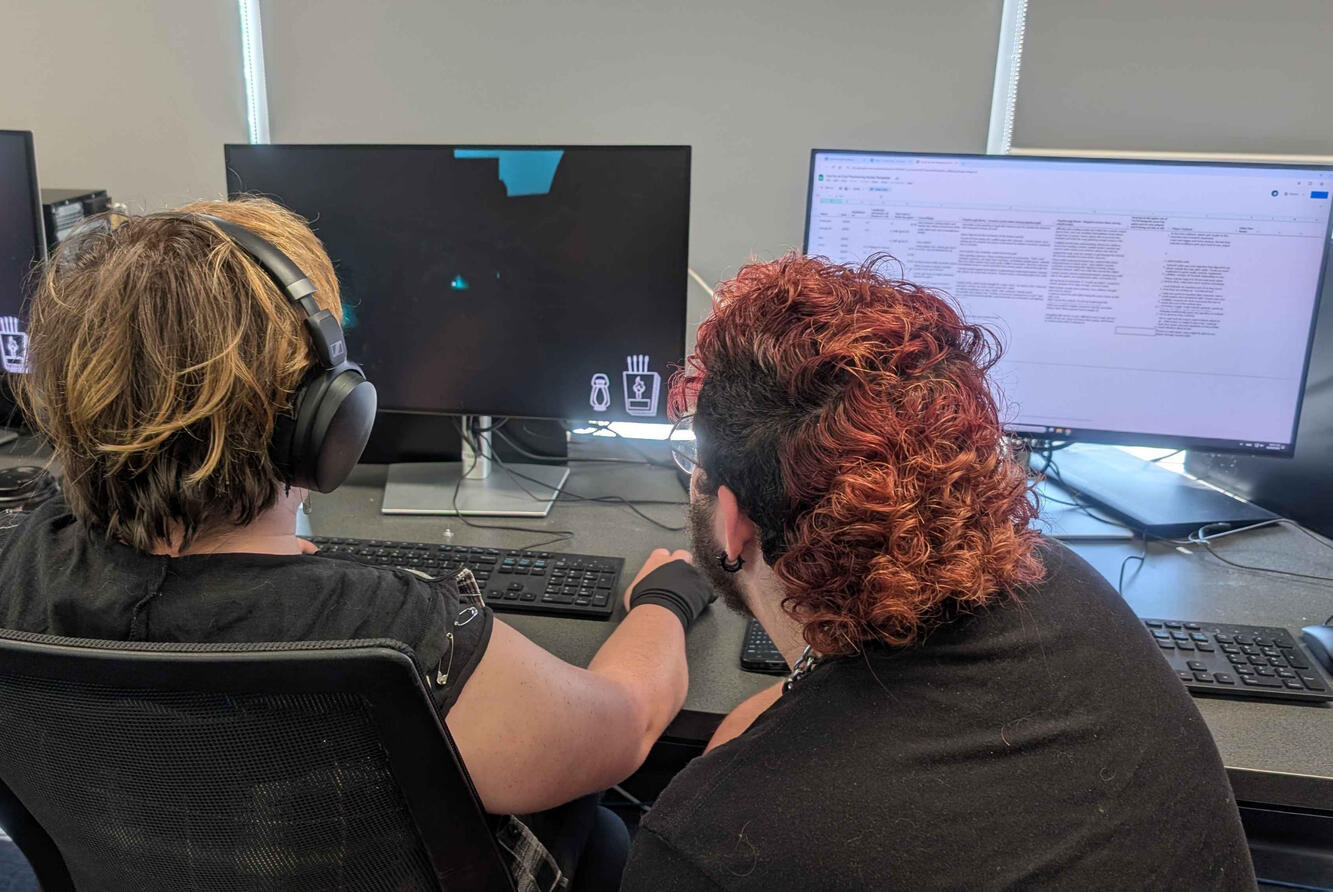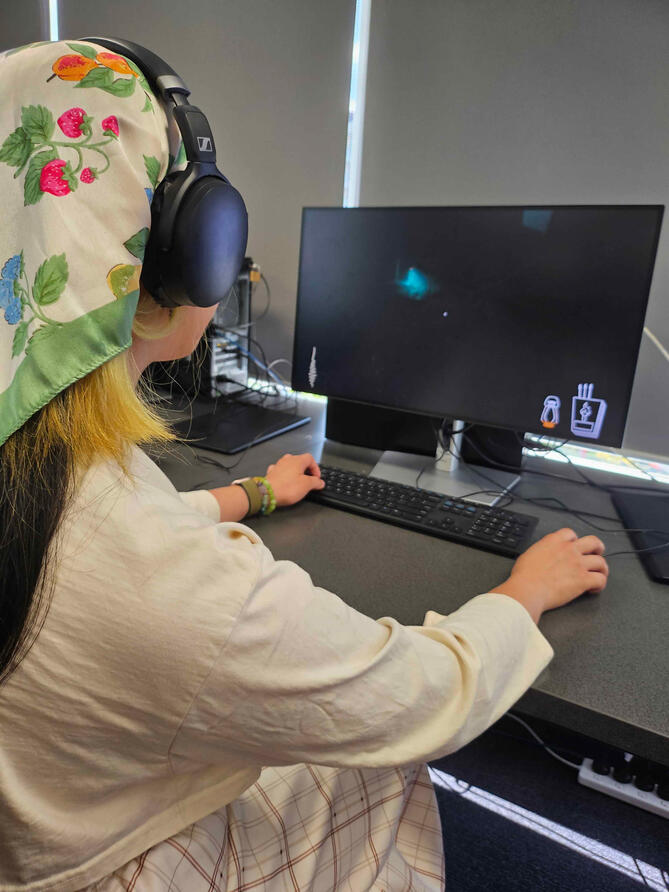EYE FOR AN EYE
A survival horror game inspired by Celtic mythology.
Watched by an ancient forest god, stealth your way through the environment to collect runes and unlock your own memories to reveal what lead you to the forest to begin with.Demo releasing late 2025.
EYE FOR AN EYE
A survival horror experience.
Eye for an Eye is a 3D survival stealth-focussed horror game inspired by Celtic mythology. Watched by an ancient forest god, you must stealth your way through the environment to collect runes, unlock your own memories and find what led you to this wretched forest. Manage your resources, plan your strategy, avoid the enemy and ultimately survive.Inspired by nostalgic horror games from the 2010's, Eye for an Eye is set in a dark forest with an intense atmosphere and dynamic survival elements. Our aim is to create an immersive horror experience using psychological terror through gameplay mechanics and environmental storytelling. Get ready to be scared!Demo releasing late 2025.
THE TEAM
Produced by the Griffith Games Design and Production Studio 2025.
Charlie Watts
Main Roles:
Associate Producer
Lead Animator
Concept Artist
Secondary Roles:
Narrative Design
3D Modelling
3D Texture Artist
Josie
Hunt
Main Roles:
Artistic Director
Concept Artist
2D Texture Artist
Secondary Roles:
Narrative Design
Blake Ellevson
Main Roles:
Technical Artist
Programmer
Sound Designer
Composer
Voice Actor
Secondary Roles:
Narrative Design
3D Modelling
Level Designer
Adrian Jaa-Kwee
Main Role:
Programmer
Holden Phillips
Main Roles:
Programmer
Secondary Role:
Level Designer
James
Cane
Main Role:
3D Modeller
Character Modeller
Trelyse
Allan
Main Role:
3D Texture Artist
3D Modeller
Secondary Role:
Concept Artist
Matthew
Wright
Main Role:
3D Modeller
Secondary Role:
Level Designer
Skye
O'Neil
Main Role:
3D Modeller
Left project in July.
TEAM REFLECTIONS
Charlie Watts
As the associate producer, I have mostly been working behind the scenes in regards to planning, asset lists, timetables and communication with the head producers of the studio. On top of this, within the game itself I modelled and animated the eyes, concept sketches for the hut and the ruins as well as narrative design. Unfortunately being lead animator fell through as we had issues with implementing self-made animations in Unreal.As a team I feel like we worked well. I enjoyed helping organise everyone and allowing us to work to our best potential. Despite the odds stacked against us through mental and physical health issues, as well as technical worries, we pulled through, and I am proud of the game we have created as a team and hope to collaborate on future projects.Working with this team was essential and forced me to learn new skills in time management, team planning and even minor elements of programming and level design to aide in collaboration. Here to many more!
Josie Hunt
From the start of trimester 1 to now, working on Eye for an Eye has proven a challenge, and with that challenge has come new opportunities to learn and grow my skills. The game has changed a lot since our initial idea, and with that so has the visual design, which was my job in the design process. Creating a visual design that displays the concept of horror and the emotion that is meant to be conveyed from the player proved to be a difficult task, and resulted in a lot of research into similar and inspiring games, as well as many themes and symbolic features that provided a resonating aesthetic and atmosphere. Trimester 2 started with our taking a turn in visual design, switching from a realistic style, to a more stylized and original design, we ended up delaying the point of time we would have liked to had assets installed. Though the extra time I needed to create the new style concepts heavily influenced and refined our game perfectly, creating a visually appealing game that I can be round of.The team for Eye for an Eye has been nothing but amazing and supportive. The group provided a safe environment to discuss and learn from each other, in which our communication has resulted in an organized and collaborative environment. Watching everyone excel and exhibit their skills has been an inspiring and rewarding process that I’m glad to be apart of.
I hope that’s okay.
Blake Ellevson
Hi, Blake here. It's been super interesting and a great learning experience working on Eye For an Eye's programming. My primary area for the game was working on Eeny's AI, and other interactive world objects, and I feel that I've come a long way since the beginning of Studio in terms of not only understanding Unreal's interface - but also what it has to offer.Creating a horror game is quite hands-on. Every minute detail of the interactions you create; the timing, volume, location etc. are more important than they would be in any other game, because you're primary objective as a Designer is to maintain that tense atmosphere and fear factor. On another note; having so many Actors housed on one map forced me to learn to better optimize my code, which was an interesting challenge, especially when Behaviour trees come into it.I've had a great time working with the team - and it's been fun to collaborate with a diverse plethora of skills all for the same idea. Coming from a team in trimester 1 that had a lot of clashing vision, I feel that I meshed much better with this crowd, and were pushing toward the same goal. Having other programmers that I can rely on has been awesome - being pleasantly surprised to open the project to a cool new system already being implemented. And as someone who isn't particularly talented in drawing, it was almost surreal to see the game come to life via concept art and more.Genuine congrats and thanks to the team for all the hard work this trimester!
Holden Phillips
As for team work, overall I believe we have been pretty good, in most of our communications, with some exceptions that even includes myself. Our collaborations has been fair on point in our discussion and decision making when developing the project. I think the biggest thing that we could have worked on was maybe the distribution of the work load primarily for the 3d models as we did have one that was absent for a lot longer period than we had anticipated and also I think having more meetings as a group would have benefited us as well. It would have allowed us to all be on the same page when it came to all areas of development rather than just being in our own section.
Adrian Jaa-Kwee
Being an assisting programmer, my role was to implement the basic features, like the HUD, player movement, and bugfixing. Although seemingly minor, I quite enjoyed specialising into smaller features, as it allowed me to dissect the optimal/bad practices, and learn from them to create modular and scalable assets.Working with Unreal Engine was intimidating, especially when the 3rd Years preferred Unity, and that I had little experience with Unreal. However, by learning off their experience via their tutorials and existing work, I could confidently use & maneuver in the engine to a reasonably contributive standard.During our art refocus, I learnt about not letting bottlenecks barr programming, especially when circumstances are out of my control. Throughout, I learned other simple skill tidbits like properly importing models, textures, and materials.Learning GitHub was especially a journey, due to the incompatibility of Unreal's binary (change one thing, whole file counts as changed) files, and Github's text-focused purpose. The experience gained was invaluable, especially with those who were even less unfamiliar with version control.When the lead production team had us in separate meetings, there was a worry the programmers and artists would be split in terms of asset implementation (e.g., the programmers being expected to import & correct models). This split caused miscommunication, but the lessons learned and the teaching experience gained from introducing an unfamilar tool would be invaluableI had a worry about performance issues, especially with the online hubbub about UE5 games being poorly optimised + using Blueprints (10x slower at runtime). This made me seek the best practices and different ways to implement features, an interesting rabbithole to go down into.Overall, working with the team was an entertaining & invaluable experience! Grats to everyone involved in this project!
James Cane
At the beginning of this trimester our goal had been to create a second enemy however due to rescoping the game we had to sideline this a focus on polishing the main area of the game, my responsibility being the main enemy. Due to limited rigging knowledge my first rig was not up to industry standard and had to be redone which ultimately did slow down production. However, once a rig was done even basic animations looked good, and I could move on to making highly sculpts of the enemy in Zbrush. These ultimately weren’t implemented in either play test due to texturing issues and the workflow between Maya, Zbrush and Unreal engine being complicated. Overall, this project has helped me expand my knowledge beyond just 3D Modelling simple and non-organic objects. I am looking forward to maintaining character design as a specialisation within the industry.
Trelyse Allan
My primary role in the development of Eye for an Eye was 3D modelling and texturing of environment assets, as well as making concept art when needed. I joined this team at the start of the trimester, the style and general themes being very different to the previous game I was working on, especially the change in game engine. I took time to study the rendering style in the concept art so that I could then replicate that in the asset’s textures, as well as the stylised proportions in the models also portrayed in the concepts. Something like finding a painterly brush in Substance Painter goes a long way in stylisation.I feel that I was able to get into a smooth optimised workflow going between programs, putting what I have learnt to practice and then being able to iterate and reflect on what I could change in the workflow for the next asset. I came across some problems during the modelling to texturing procedure like baking high onto low poly, but I was able to solve this with trials and experimentation between programs. There are a lot of small things that matter in terms of creating a smooth process, so it was very satisfying when the assets were going well.Working with this new team was wonderful, the concept art of the game was very strong and consistent, so it was definitely easier to visualise the end artistic goal for the game. Also coming from a different team, I felt that the goals were very organised and communicated effectively which was an awesome surprise. And to allow for a reflective process in my modelling and texturing, I was able to receive good feedback from the team with each iteration so that the assets would best match the style guide and what the whole team visualised. It felt even more exciting to see how the assets meshed with the lighting and atmosphere of the game and its thought-out technical mechanics to paint a fear inducing environment.Good job to everyone!
THE BEGINNING
Scope Review and Plan
The scope of this project had to be planned out, however significant work needed to be done to make the vertical slice achievable within the deadlines outlined by studio producers.Our prototype as of the end of last trimester included a fully greyboxed scene in Unreal Engine 5.5 for the first area of the game, as well as the safe zone of the “stone circle” in the middle of the playable area. We also had the first enemy’s low polygon model completed with a variety of assets ready to be implemented into the game engine.Unfortunately, after reassessing the goal of the game and the scope for the vertical slice, we had to make significant changes to the games style.During the scope review and vertical slice planning phase our Art Director and Associate producer began to finesse the new style and create said style guide. The risks of this redo plan were evident as these new style choices meant a lot of extra work for the 3D team but we felt the original hyper-realistic style of the game didn’t fit the studios goals for a unique and avant-garde creation therefore, this change was essential for the production.
Within the design elements during this initial stage of production, Josie Hunt, had to begin with a new draft for the level map. Following the level design planning and collaboration for the previous week. Charlie Watts the associate producer, was tasked with streamlining production of 3D assets.Unfortunately, due to issues within the GitHub, both Blake and Holden had to restructure it, which delayed their progress on tasks.
As associate producer, Charlie began to set up a better method of sharing tasks, as well as designating an outside-of-studio-time meeting at time that was convenient for each member of the team. We also had consistent check-ins each week and used Flow to supplement this organisation.In the initial weeks of production, our visual styles changed which was led by art director, Josie Hunt, and supported by Charlie Watts and Trelyse Allan. They all also worked together to complete turnarounds for certain essential assets.Once Josie had completed the level map, the programmers, Holden as well as Adrian Jaa-Kwee, could begin with a revamped greybox of the level itself. Our character specialist, James Cane, finalised the base skeleton of our enemy so that we could begin animation.
See images of our initial greybox below:
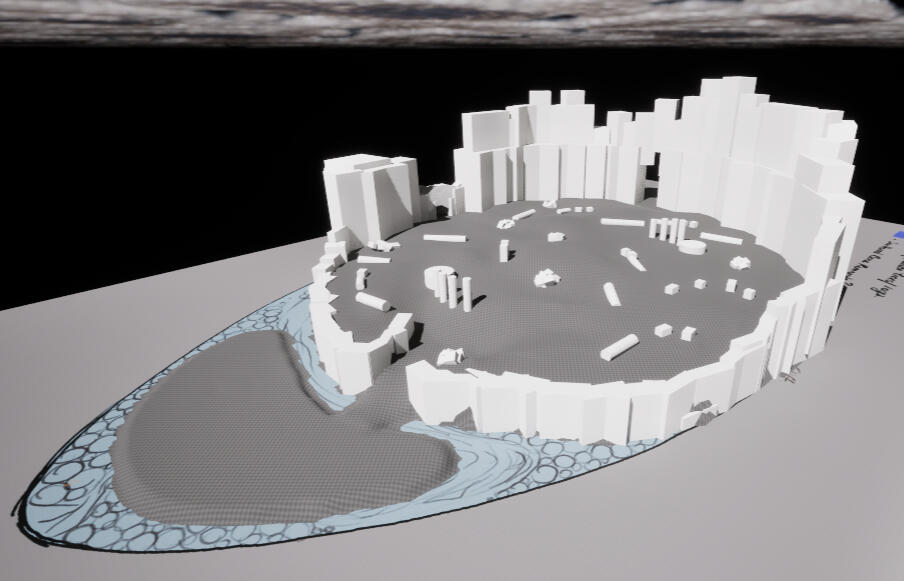
Credit: Blake Ellevson
Due to losing one of our 3D modellers Skye, as well as issues with GitHub and the enemy rigging process, these produced significant obstacles for the production.We were assigned another 3D modeller Trelyse, as studio producers felt they would be a better fit. Tasking a programmer to focus solely on fixing GitHub for the first segment of the month – as well as keeping in organised throughout the project – and honing in on the rigging with James specialising only on the enemy so that he became most familiar with its requirements and processes.
THE PRODUCTION PLAN: PART ONE
July, Weeks 2-4
Once scope of the project had been planned out, we began production. This involved redefining the games development document, style guide and technical plan.Charlie Watts, lead Animator, planned on beginning the animation over the course of prototyping however due to complications with rigging from the character modeller James, he was not able to, which delayed production back slightly.
The remodelling of assets took up the majority of the time that the 3D team had been allocated for the vertical slice.Skye was eventually internally reassigned to another project within the studio, so her 3D remodelling was given over to Trelyse. Over the month of July, the 3D modelling team had to remodel the stone circle, a key element to the core gameplay loop, as well as the lantern, oil bottle, matches and the main enemy before moving on to any additional lower priority assets.We updated the gameplay mechanics by updating the games stealth system to reflect the updated style guide. Adrian and Holden started on a proximity-based system, in which eyes were placed in trees the forest would detect the player and alert the enemy to their position.This meant that the player would always feel the enemies’ presence as prior feedback from testing the game showed the enemy was too scarce amongst the map. Holden and Blake continued on the level design of the map via implementing that into the level itself. Holden also engaged in experimenting with procedural generation to aide in the asset placement and take strain off of both the level design workflow.Our narrative designers Blake, Charlie and Josie who had knowledge of the concept designs, began to plan a more organised and environmentally grounded narrative for the game. We had previously been using runes for the collectables for the player this was aligned to the runes in Celtic mythology, setting the world within the forest of an unspecified ancient Celtic god. Blake suggested some backstory for our enemy and how he became the rock creature which was then tied into
Charlie Watts, our lead animator, planned on beginning the animation over this month, however due to complications with rigging from our modeller James, he was not able to, which shifted production back slightly.
The code for the "eyes in trees" system:
PLACEHOLDER

Credit: UNKNOWN
While the programmers, Blake Ellevson, Adrian Jaa-Kwee and Holden Phillips, honed their focus onto the core mechanics of the game as we wanted to make sure the final prototype had all of the key elements – these being a stamina bar, lantern with both oil and matches as well as multiple lighting modes and running and crouching for the player on top of their normal walking cycle.Moon phases were meant to control when the enemy gets more difficult and how the enemy would react to the player, however through gameplay and using an iterative development model we ended up vetoing this idea due to the already present high amount of lighting planned and created.The cinematography was finally able to begin being implemented, with our technical artist Blake creating a kickstart for the lighting and sound design by the end of this month.We hope to implement more sound design as well as subtitles to give more accessibility amongst the game.
Video with initial lighting and sound design:
Credit: Blake Ellevson and Adrian Jaa-Kwee
As the deaths of the enemy (and subsequently planned enemies) were linked to the story. The plan being that the player was hiking with his friends and, due to a sequence of events, his friends died one by one – all in ways in which he could help. The prototype enemy dies via being crushed by rocks, ergo, we needed this within the environment. Due to these deaths, the player is being punished by an old Celtic god, which story-wise shall be shown through the environment as well as cutscenes within the game.We engaged with diverse audiences through the use of both audio and visuals to indicate the eyeball mechanics and enemy. This allows people with limited vision or who are hard of hearing to engage with the game and not be given a disadvantage or lack of access to the mechanics.
THE PRODUCTION PLAN:
PART TWO
August, Week 5-7
When production sprints began; integration of assets, audio as well running internal playtesting with a focus production on finalising key features, and preparing for the proper playtesting at the end of the month.The sprints are incredibly interlinked, requiring rigorous team collaboration on both Monday and Friday production meetings.
3D modeller Trelyse Allan was focussed on the main ruins model, a key asset that was required for the playtest to have a secondary stage. Josie Hunt, focussed on texturing the lantern and the rocks, the trees and a smaller ruin.
Matthew Wright, was finalising both the stone circle and the hut which are both key game and story elements.James Cane, was tasked with finishing the higher polygon sculpt of the main enemy of the game. Lead animator, Charlie Watts was tasked with finishing texture plans for the trees as well as enemy animations now that the rig had been completed. The programming team in conjunction with the level designers began to finalise and implement the golden path plans from the previous month and prepare and research the implementations of animations.The narrative was being worked on by both Josie Hunt and Charlie Watts, interlinking with the level design with help from Blake Ellevsen. We planned how implemented assets would visually tell the story as feedback from studio producers was, they did not want lots of words to explain the narrative Blake suggested that the hut would be visually crushed to show how the enemy died which ended being a key narrative element.
The test animation that unfortunately was not able to make it to the final production:
Credit: Charlie Watts
Charlie, was tasked with implementing animation techniques, however obstacles through the rigging progress caused this to be Delayed. Initially James’ rig was unworkable and requiring it to be redone. Following that, Charlie created animations that unable to implemented within the Unreal Engine due to limited knowledge and a difficult pipeline between Unreal Engine and Maya. After more research and to ensure animations were implemented into the prototype, animations had been done via use of motion capture, specifically Mixamo. Together both Charlie and Blake tried to finesse and work with the animations over the production sprints, but despite this work and collaboration they did not make it to the final game, this delay did impact team morale.While there were many obstacles during production over this month, both finding solutions via either removal – in regards to the animations – and overcoming the odds – with the completion of work in a short amount of time and working through both assessment due dates and demoralising situations – this prepares us for working in the cutthroat nature of the game design and production industry, as well as with managing our own mental health in times of strife and when work falls through.
Due to the development style of the enemy AI, requiring bugs to be fixed and tweaks to be done as production sprints continued. Blake specifically was tasked with the enemy AI, but the programming team worked with significant.Through collaboration, we were able to overcome difficulties and solve problems, as well as communicate effectively. The entire process this month of constant fixes, as well as needing to push back certain production workflows and adapt to changes, aides us in the industry practices of resilience which is important in such an ever-changing environment like games design, especially when the whims of the production can hinge on the technology available and its willingness to listen to the programmers.
Snippet of enemy AI programming:

Credit: Blake Ellevson
Josie’s focus before internal playtesting was implementing the cutscenes. Adrian also continued to fix the visuals and integration of the moon phases. These were originally planned in previous iterations during the prototyping phase however were cut from the final vertical slice.
The initial cutscene at the end of the month:

Credit: Josie Hunt
THE PLAYTESTS
September, Week 8-10
Finally, the playtesting had begun, initially with an internal playtest. During this initial playtest, our associate producer, Charlie Watts, took feedback, while 3D modeller James Cane was the front of the operation and both read and wrote the script. This month was focussed on collecting detailed feedback, as well as prioritising fixes and improvements.
Images from our internal playtesting:
After Holden implemented the tutorial level survey results showed 20% more people believed the tutorial was effective and 20% more people felt it was obvious what player could interact with.Strangely, 15% less players thought that the games’ goal was clear and 20% more didn’t know where the game was sending them.By the final vertical slice, we are hoping to add more visual information, our Art Director, was focussed on making tangible visual UI to aid any player to be aware of what is needed. We hope to add subtitles by the final prototype of the game. The cutscenes had non-specific gendering, with the characters having diverse shapes and visuals to help reach and engage a wider range of audiences.
A high amount of confusion seemed to have come from conflicting lighting and needing more guidance. These contradictions meant we needed to work more on the level design before publishing, with Blake, Holden and Adrian tasked with this – due to time constraints this with mainly be done through improving UI and finessing the lighting mechanics, specifically by making the safer lighting brighter, and the contrast between the enemy’s lighting colours and the safe area lighting colours stronger.
Implemented Eyes (with animations):
Credit: Charlie Watts, Adrian Jaa-Kwee and Blake Ellevson
Due to personal conflicts, Matthew Wright, 3D modeller, hadn’t completed the hut by the initial playtest so this task was given over to Trelyse Allan.
The Hut:
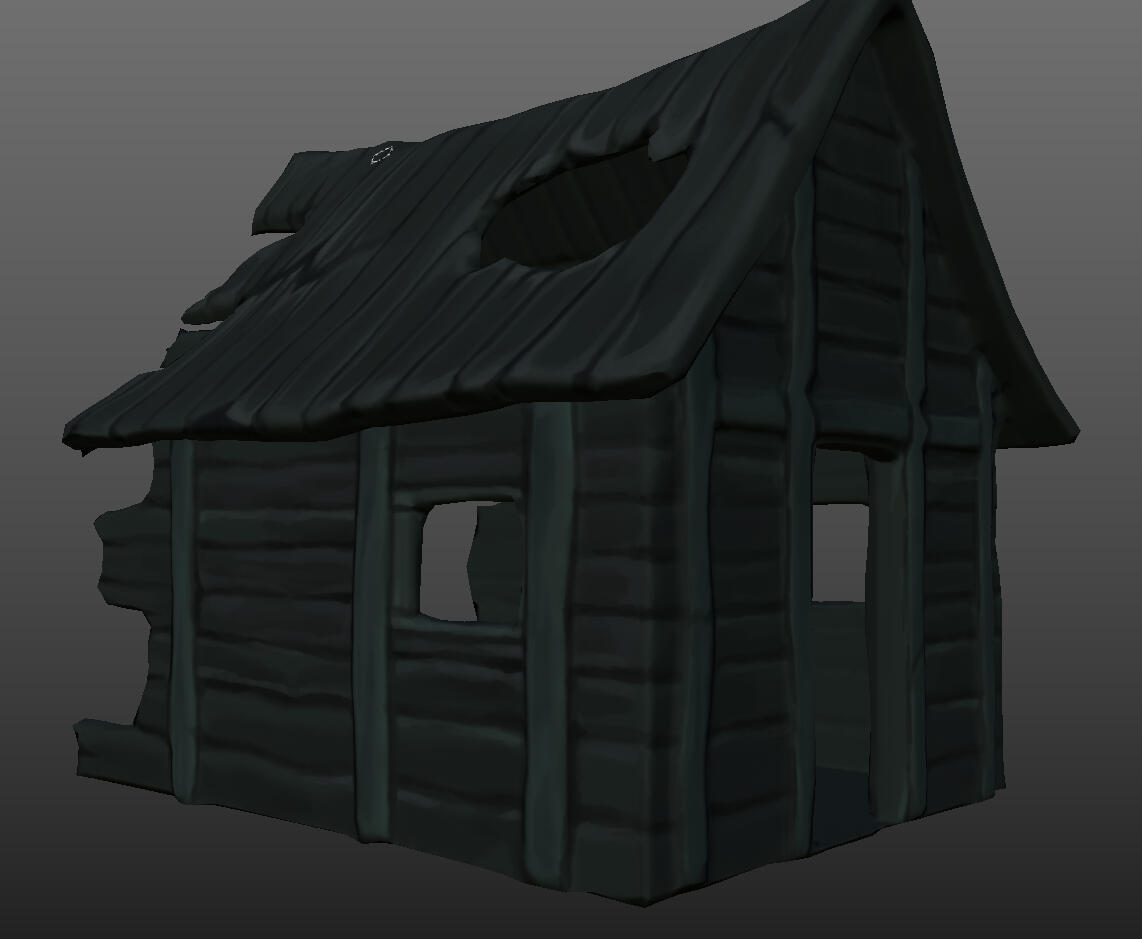
Credit: Trelyse Allan
James’ cliffs still had not been implemented yet, which meant that the boundaries kept breaking for players, so this had to be finished by before production is complete. Some of the controls also confused players – specifically TAB for pause and CTRL for crouch – so we are currently considering changing these controls to more intuitive options.
The Cliffs (low poly):
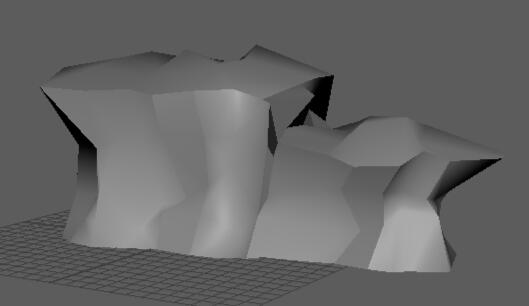
Credit: James Cane
Before the final iteration of the game, the enemy also needs to be unwrapped again due to texturing conflicts, which was tasked to James as the enemy was his specialty.Josie was given the task of finalising the cutscenes of the game. Players believed the cutscenes were not obvious in what they meant so we are hoping that finalising these may aide in that issue. Implementing the enemy animations should also help – which shall be done by Blake – as some players believed that the enemy “was not scary” (Anonymous, 2025), and that the lack of animation was “goofy” (Anonymous, 2025) – this was already something we planned to do, but hopefully this need for it will speed up both the process and contribute to quality due to feedback. We also hope to finally implement subtitles to aide in accessibility of the game.
Images from our public playtesting:
At the end of the playtest, the amount of players who felt the environmental storytelling was clear and the visuals were immersive remained the same, however 10% more players had fun playing the game, and 80% of people said that they would recommend it to someone else.Players found the game scary, and the enemy indicators immersive and highly effective. Many players specifically enjoyed the fear factor of the eye mechanics. Players also referred to the game as “nostalgic” (Link, 2025), comparing it to both Slenderman: The Eight Pages (2012) and Alien: Isolation (2014) respectively.
Despite all of this, 90% of players said the sound design was immersive, 60% of people said the environmental storytelling was clear, 80% of players were immersed in the visuals and 70% had fun playing the game – so overall the internal playtesting was a success.Before our eyes, the public playtesting had begun. Yet again, James was the frontrunner of the playtest with the script – revamped for the public – with Charlie doing feedback. Due to the influx of playtesters, Adrian also ended up taking feedback notes as well. The task of this was to document insights for the final interation, as well as gathering structured player feedback.















